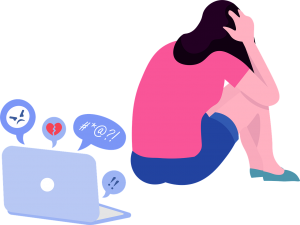Digital Anxiety — How Technology and Social Media Makes Us Anxious and What You Can Do About It
 Life is unpredictable and anxiety-producing. There’s no doubt that technology and social media have intensified our anxiety, and our lack of in-person connection and interaction, time in nature, and engagement in our communities is creating what some mental health professionals are referring to as “digital anxiety.”
Life is unpredictable and anxiety-producing. There’s no doubt that technology and social media have intensified our anxiety, and our lack of in-person connection and interaction, time in nature, and engagement in our communities is creating what some mental health professionals are referring to as “digital anxiety.”
What is digital anxiety?
An example of digital anxiety is stress caused by negative interactions from a text, an email, or a social media post. Other examples of digital anxiety are feelings of inadequacy, hopelessness, FOMO (fear of missing out), and envy stemming from social media consumption as well as feelings of loneliness and social isolation from spending too much time on screens.
People can also experience digital anxiety when physically separated from their phones. Like those struggling with generalized anxiety disorder, individuals with digital anxiety experience excessive worry and anxiety but their anxiety stems from being “disconnected.”
Addressing anxiety of all kinds is crucial for taking care of our physical health as well as our emotional health. Below are a few recommendations to help you get started.
Tips for Addressing Digital Anxiety
1. Be honest with yourself about your digital habits. Record how often you are engaged with screens and technology. Take note of things such as the time of day you are most likely to log on and how you feel before and after you log on. Getting honest with yourself about how often you interact with technology is a BIG step towards cultivating self-awareness.
2. Accept that anxiety is a part of living (both online and offline). Life is unpredictable and often beyond our control. Make a daily commitment to practice the DBT skill of radical acceptance, the ability to accept our reality without judgment. Radical acceptance does not mean we approve of negative events and situations that have happened or are happening but, rather, that we accept these circumstances, no matter how difficult they feel and are, as realities we might not be able to change at this very moment or ever.
3. Keep an anxiety journal. Journaling on a regular basis has been shown to relieve stress and anxiety. It helps with problem-solving and focuses our attention on specific goals and with processing unresolved feelings such as of grief and anger both of which can cause anxiety.
4. Limit social media and screen time. One way in which social media exacerbates anxiety stems from comparing one’s self to virtual friends and or social media influencers. Scheduling and putting firm time limits on your social media check-ins is one way to take charge of your digital habits. Prioritizing time spent with friends and family and engaging in offline activities such as hobbies, reading, and exercise are other ways to take charge of one’s anxiety in the digital age.
5. Commit to daily non-digital self-care practices. Self-care is the intentional act of taking time to pay attention to you. Examples of non-digital self-care practices are exercise, time with friends, listening to music, spending time with a beloved pet, reading, or engaging in a hobby.
Excerpted from “Digital Anxiety” in Psychology Today. Read the full article online.
Source: Psychology Today | Digital Anxiety, https://www.psychologytoday.com/us/blog/logged-in-and-stressed-out/202303/digital-anxiety | © 2023 Sussex Publishers, LLC
A screening can help you determine if you or someone you care about should contact a mental health professional. Care Coordinators can arrange a free 30-minute Care Consultation so you can explore options with an expert. Call or email us at 650.688.3625 or careteam@testing.chconline.org to set up an initial Consultation appointment.





